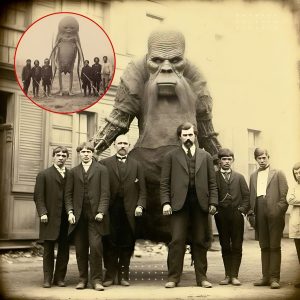In a remarkable and shocking archaeological discovery, researchers have unearthed hundreds of giant human bodies in an ancient tomb in Nigeria. This finding, which has left the scientific community and the public astounded, offers new insights into the region’s ancient history and raises intriguing questions about its past civilizations.
The discovery was made during an excavation project in the Oyo State, a region known for its rich cultural heritage and historical significance. Archaeologists, who were initially investigating what they believed to be a common burial site, were stunned to uncover the remains of individuals of extraordinary size. The tomb, which dates back several centuries, contained skeletal remains that were significantly larger than those of average humans, suggesting the existence of a previously unknown population of giants.

The excavation team, led by Dr. Folake Okeowo, has been meticulously documenting and analyzing the remains. Preliminary measurements indicate that some of the skeletons belonged to individuals who were over seven feet tall, with some even reaching heights of nine feet. This discovery challenges existing knowledge about the region’s ancient inhabitants and has sparked widespread speculation and curiosity.
One of the most intriguing aspects of this discovery is the potential historical and cultural implications. Ancient Nigerian folklore and oral traditions often mention the presence of giants, referred to as “Nda” or “Orunmila,” who were believed to possess great strength and wisdom. These legends, long considered mythological, may now hold a kernel of truth, supported by this archaeological evidence. The connection between these skeletal remains and the mythical giants of Nigerian lore could provide valuable insights into the cultural and spiritual beliefs of ancient societies in the region.
The discovery also raises questions about the health, lifestyle, and causes of death of these ancient giants. Researchers are conducting various tests, including DNA analysis and radiocarbon dating, to determine the age of the remains and gain a deeper understanding of the genetic makeup of these individuals. The presence of such large individuals suggests unique environmental or genetic factors that contributed to their growth. Additionally, the tomb’s contents, including artifacts and burial goods, are being carefully examined to shed light on the societal structures and practices of the time.
The public reaction to this discovery has been a mix of awe and fascination. Social media platforms have been abuzz with theories and discussions about the implications of finding such large human remains. Many are eager to learn more about the origins and lives of these ancient giants, while others speculate about potential connections to other giant-related discoveries around the world. This unprecedented find has certainly captured the imagination of people worldwide, reigniting interest in the mysteries of ancient human history.
Dr. Okeowo and her team are committed to preserving and studying the site with the utmost care. They have called for international collaboration to ensure that the findings are thoroughly examined and understood within a global context. The Nigerian government has also expressed its support for the project, recognizing its potential to enhance the country’s cultural heritage and contribute to the global understanding of ancient human civilizations.
In conclusion, the unearthing of hundreds of giant bodies in an ancient Nigerian tomb is a groundbreaking discovery that challenges our understanding of history and opens up new avenues for research. As scientists continue to investigate and analyze these remains, the world eagerly awaits more information about the lives and significance of these ancient giants. This remarkable find not only enriches our knowledge of Nigeria’s past but also highlights the endless possibilities and surprises that lie hidden beneath the surface of our planet.





